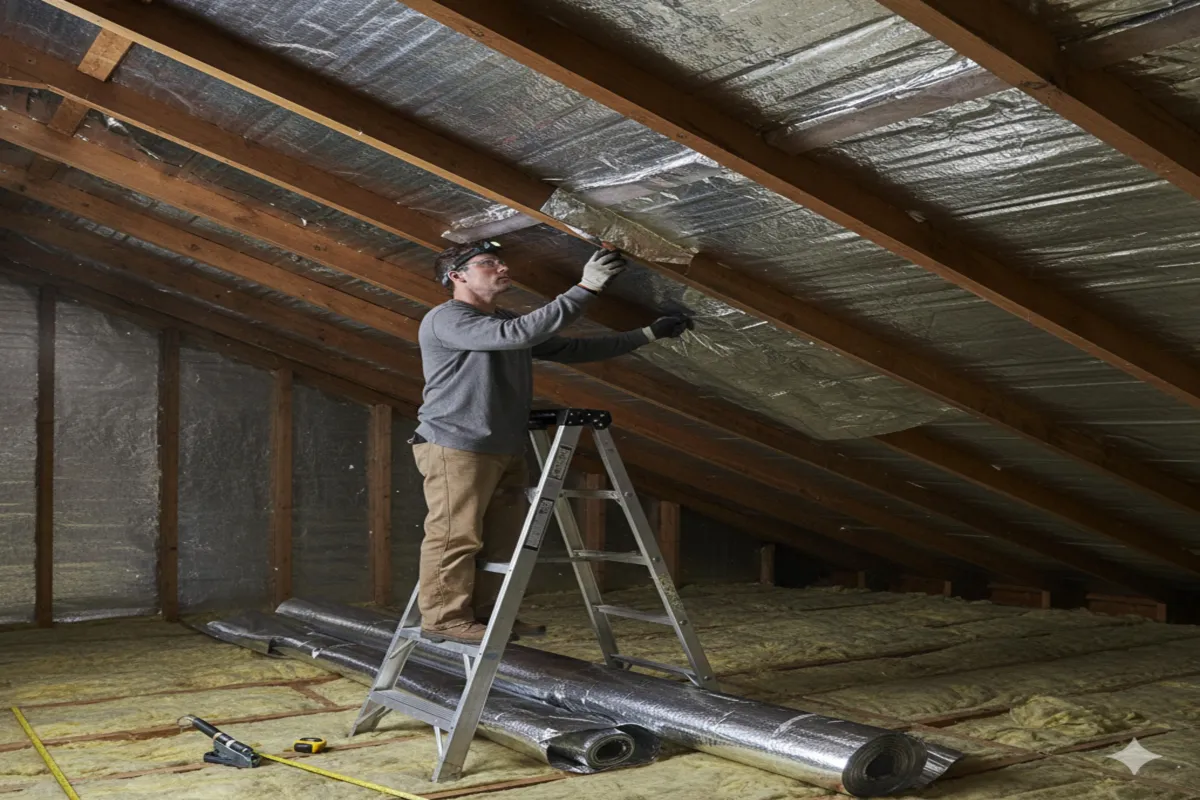
How Radiant Barrier in Attics Improves Comfort Year-Round
Your attic does more than just store old boxes—it plays a huge role in your home’s comfort and energy efficiency. In summer, attic temperatures can soar past 140°F, radiating heat down into your living space. In winter, that same attic can allow warmth to escape, forcing your heater to work harder.
The good news? You can stop this energy loss and temperature imbalance with one smart upgrade — a radiant barrier.
A radiant barrier installed in your attic acts as a thermal shield, reflecting radiant heat in the summer and preserving warmth in the winter. It’s one of the simplest, most cost-effective ways to make your home comfortable year-round — and lower your energy bills in the process.
What Is a Radiant Barrier and How Does It Work?
A radiant barrier is a highly reflective material, often made of aluminum foil or foil-faced insulation, installed under the roof or over attic insulation.
Instead of absorbing heat, it reflects up to 97% of radiant energy—the same principle that keeps astronauts cool in space suits or food warm in foil wrap.
How It Works:
Summer: Reflects the sun’s radiant heat away from your home, keeping the attic cooler.
Winter: Reduces radiant heat loss by reflecting warmth back into your living space.
Result: Consistent indoor temperature and reduced HVAC workload all year long.
Why Attic Radiant Barriers Are Essential Year-Round
Summer: Keep the Heat Out
During hot months, radiant energy from the sun heats your roof. That heat transfers into the attic, raising indoor temperatures and forcing your AC to run nonstop.
A radiant barrier installed under the roof decking acts like a mirror for heat, reflecting it back before it ever enters your attic space.
Benefits:
Reduces attic temperature by 20–30°F
Keeps upstairs rooms cooler
Lowers AC energy consumption
Prevents heat buildup that can damage insulation

Winter: Keep the Warmth In
In cold weather, your home’s heat rises and escapes through the attic. A radiant barrier helps trap heat inside by reflecting it back downward, reducing heat loss.
Benefits:
Retains indoor warmth
Reduces heating costs
Prevents cold drafts from attic leakage
Keeps comfort consistent throughout the home
The Science Behind the Year-Round Efficiency
Traditional insulation (like fiberglass or cellulose) slows heat transfer through conduction, but radiant barriers stop radiant heat entirely.
Conduction: Heat transfer through solid materials (e.g., walls, roof).
Convection: Heat transfer through air movement.
Radiation: Heat transfer through electromagnetic waves (like sunlight).
A radiant barrier focuses on radiation, which is responsible for most heat gain or loss through the roof. By reflecting it, your attic remains balanced in every season.
Key Benefits of Radiant Barrier Attic Insulation
1. Lower Energy Bills
By reducing your HVAC system’s workload, radiant barriers can cut cooling and heating costs by up to 15%.
2. Enhanced Indoor Comfort
You’ll notice a more even temperature across all rooms — no more hot upper floors or chilly corners.
3. Extended Roof and HVAC Lifespan
Lower attic heat means less strain on roofing materials and HVAC units, increasing their durability.
4. Eco-Friendly Energy Efficiency
Using less energy helps reduce your carbon footprint. Radiant barriers are a sustainable step toward greener living.
5. Boosted Home Value
Energy-efficient homes sell faster and at higher prices. Installing radiant barrier insulation adds to your home’s resale appeal.
Radiant Barrier Installation Options
Depending on your attic’s design and needs, radiant barriers can be installed in several ways:
1. Under-Rafter Installation (Staple-Up Method)
Foil is stapled to the underside of roof rafters—perfect for new builds or accessible attics.
2. Over-Insulation Installation (Lay-Over Method)
The barrier is laid over existing attic insulation, ideal for retrofits.
3. Spray-On Radiant Coating
Reflective coating sprayed directly on roof decking — best for complex attic spaces.
4. Foil-Faced Insulation Boards
Combines radiant and thermal insulation, offering double protection.
Best Practices for Optimal Performance
Ensure proper attic ventilation to allow heat to escape.
Maintain a 1–2 inch air gap for maximum reflectivity.
Avoid dust accumulation — it can reduce reflectivity.
Combine with ridge and soffit vents for full airflow.
Hire professionals for correct and safe installation.
Common Myths About Radiant Barriers
Myth 1: “Radiant barriers replace insulation.”
Fact: They complement insulation for better results.
Myth 2: “They only work in hot climates.”
Fact: They also reduce heat loss during winter.
Myth 3: “They’re too expensive.”
Fact: They’re one of the most cost-effective upgrades for energy savings.
Conclusion: Comfort and Savings Every Season
No matter the season, radiant barrier attic insulation offers comfort, protection, and efficiency. It’s a smart investment that pays for itself through energy savings, enhanced comfort, and long-lasting roof performance.
At BCP Inc., we provide premium radiant barrier materials that keep your attic — and your home — energy-efficient all year long.
Email: [email protected]
Contact: 877-540-5678